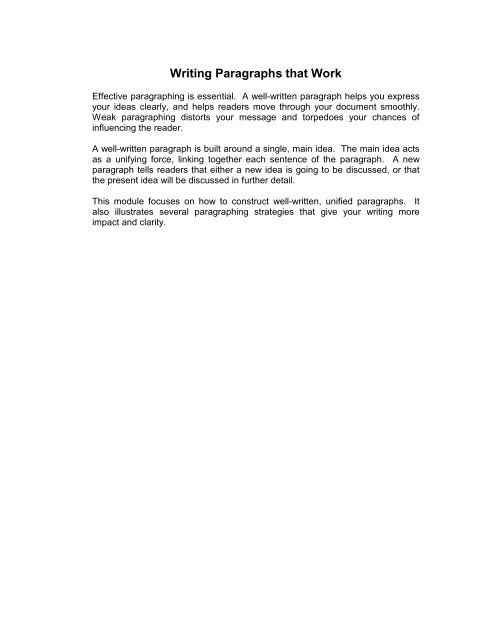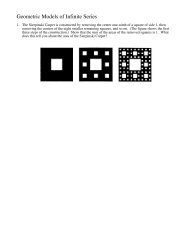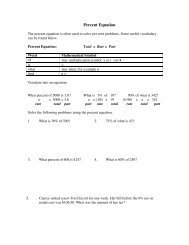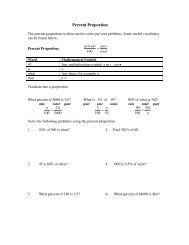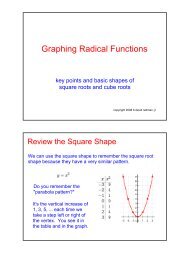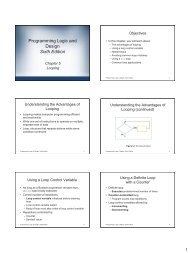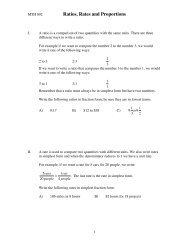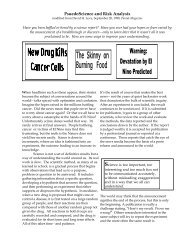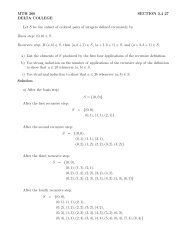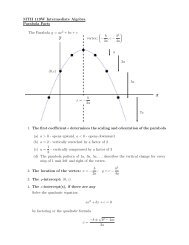Writing Paragraphs that Work
Writing Paragraphs that Work
Writing Paragraphs that Work
You also want an ePaper? Increase the reach of your titles
YUMPU automatically turns print PDFs into web optimized ePapers that Google loves.
<strong>Writing</strong> <strong>Paragraphs</strong> <strong>that</strong> <strong>Work</strong>Effective paragraphing is essential. A well-written paragraph helps you expressyour ideas clearly, and helps readers move through your document smoothly.Weak paragraphing distorts your message and torpedoes your chances ofinfluencing the reader.A well-written paragraph is built around a single, main idea. The main idea actsas a unifying force, linking together each sentence of the paragraph. A newparagraph tells readers <strong>that</strong> either a new idea is going to be discussed, or <strong>that</strong>the present idea will be discussed in further detail.This module focuses on how to construct well-written, unified paragraphs. Italso illustrates several paragraphing strategies <strong>that</strong> give your writing moreimpact and clarity.
1. The Well Written ParagraphWhat are the characteristics of a well-written paragraph?A. UnityA paragraph is unified when all of its parts work together to support the mainidea. To insure unity, ask yourself the following questions about each paragraphin your document:• What is its purpose?• What is the main point?• Does each sentence support and develop the main point?• Does the paragraph accomplish its purpose?B. CoherenceA paragraph is coherent when each sentence flows naturally from one toanother, forming a logical chain of thought. Sentences should be sequenced toconvey your message to readers clearly. Create coherence by using transitionsand logical connectors, effective organizational schemes, varied sentencepatterns and lengths, and pronouns.C. LengthEffective paragraphs come in a variety of sizes. The length of a paragraphdepends on how complex your main idea is. If the main idea is simple, thenincluding unnecessary data will distract the reader. More complex ideas mayrequire several sentences or even several separate paragraphs.Effective paragraphs are unified and coherent.depends on the complexity of the main idea.The length of a paragraph
2. Exceptional <strong>Paragraphs</strong>Some paragraphs break the rules. They do not adhere to the guidelines ofunity, coherence, and length because they perform special functions in adocument.A. IntroductionsIntroductory paragraphs are often a single sentence in length. A memo maybegin with a greeting <strong>that</strong> includes a reference to the subject. Reports oftenopen with special paragraphs outlining the contents. Such paragraphs do notrequire transitional phrases and logical connectors.B. TransitionsA paragraph may also function as a transition between different parts of a report.Transitional paragraphs should prepare readers for a change in direction.C. Emphatic <strong>Paragraphs</strong>When you want to draw the reader’s attention to a particular point, you can set itoff in a one or two-sentence paragraph. Emphatic paragraphs are verydramatic, and serve to emphasize critical points in your documents.D. ConclusionsLike introductions, closing paragraphs vary in length. A report may need a longconcluding paragraph recommending specific actions, summarizing key points,or echoing the introduction. In memos, a one-sentence paragraph thanking thereader may be appropriate.Certain paragraphs have special functions within a document and do not followthe general guidelines for well-written paragraphs.
Total chlorophylls mg/ g4504003503002502001501000 7 14 21Storage duration (Days)Figure 8. Changes of total chlorophyll of broccoli florets during storage.Each bar is the mean of three samples.Visual quality: Visual quality of Brussels sprouts was examinedby using of two criteria. (1) Number of yellowing outer leaves and(2) visual quality scores. All these assessments were performedby panelists. According to this evaluation, number of yellowingouter leaves of Brussels sprouts heads was highest in K, followedby A and L, respectively, during the storage. The same trend wasobtained by visual quality score results. So heads in L treatmenthad higher quality score than the other two treatments duringstorage. Thus at the end of the storage, number of yellowingleaves and quality scores of L treatment were 15.67 and 2.33respectively, so the green colour of heads in L treatment wasretained better than in the other two treatments during storage(Fig. 8a, b).Yellowing outherleaves (number)Visual quality scores252015105065432100 7 14 21Storage duration (Days)(a)0 7 14 21Storage duration (Days)(b)Figure 8. (a) Yellowing leaves number and (b) visual quality scoreschanges in Brussels sprouts during storage. Each bar is the mean of threesamples.KLAKLAKLAThe quality scores of broccoli florets declined progressively inall treatments during storage (Fig.9a). In K, however, the qualityscores decreased more slowly than in the two other treatments.The opening of florets of broccoli increased during storage, butas quality scores, in K treatment this value was lesser than in theother two treatments. In contrast to Brussels sprouts, the visualquality was retained best in K, followed by L and A, respectivelyduring storage (Fig.9b).Opening floretsnumberVisual quality scores654321065432100 7 14 21Storage duration (Days)(a)0 7 14 21Storage duration (Days)(b)Figure 9. (a) Opening florets number and (b) visual quality scoreschanges in broccoli during storage. Each bar is the mean of threesamples.DiscussionWeight losses of Brussels sprouts heads in A increasedsignificantly (p < 0.05) during storage (Fig. 1) exceeding 7.0% atDay 14 and also 10.0% at the end of the storage. Robinson et al. 12considered 8% as the maximum acceptable weight loss for Brusselssprouts. So the heads in this treatment lost their saleable qualityat Day 14. In L and K treatments the weight loss was less, at theend of the storage only 6.9 and 2.9%, respectively. An accepteablelimit of weight loss of horticultural products is 10% 13 . Weightlosses of broccoli florets in K were lower than in L and A treatmentsand never exceeded the acceptable limit whereas in A weight losswas 11.4% at Day 14.It is common to store fresh horticultural products in the darknessbecause of retaining better quality and reducing water losses.However, we showed <strong>that</strong> in heads of Brussels sprouts andbroccoli florets in L, quality retained alike in K treatment.Furthermore, weight loss of Brussels sprouts heads was 6.9%KLAKLAJournal of Food, Agriculture & Environment, Vol.5 (3&4), July-October 2007 129


